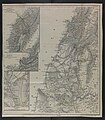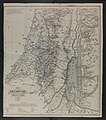Miniara is a village in Akkar Governorate, Lebanon, 9 kilometers east of the Mediterranean Sea, and 3 kilometers south of Halba. The population is between 7,000 and 10,000.
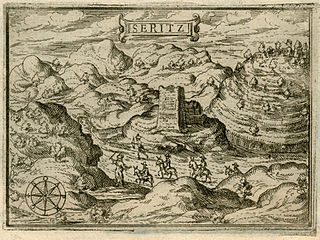
Saris was a Palestinian Arab village that was depopulated during the major offensive launched by the Haganah on 16 April 1948. Called Operation Nachshon, and launched before the British had left Palestine, its objective was to capture villages between Jerusalem and the coastal plain, in order to break to siege of the Jews of Jerusalem.
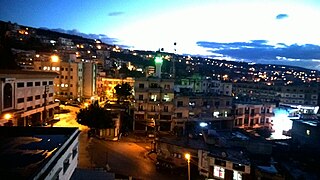
Halba is the capital of Akkar Governorate in northern Lebanon, close to the border with Syria. It is located at around 34°33′2″N36°4′41″E. Its population is divided between Sunni Muslim, Greek Orthodox Christians, Maronites, and followers of other religions.

Rachaya Al Foukhar is a Lebanese village in the district of Hasbaya in the Nabatiye Governorate in southern Lebanon. It is located on the western slopes of Mount Hermon at an altitude starting at 750 m with the highest summit being at 1,250 m. The population is Greek Orthodox.
Cheikh Mohammad is a village situated in Akkar Governorate, Lebanon. Situated 400 metres above sea level, in between two mountains, it overlooks the Akkar plains and sea. It is made up of approximately 450 houses, with 99% of the population being Christian, mostly Greek Orthodox, Melkite Catholics and Maronites. This small village contains two schools, a primary and secondary as well as two churches, one dating back hundreds of years. It also has the very first hospital in Akkar, named "Akkar Rahal Hospital".
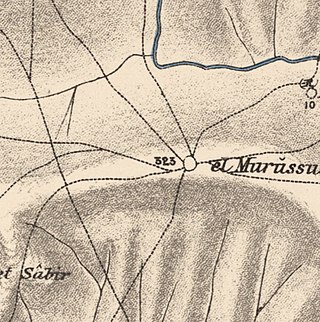
Al-Murassas, was a Palestinian Arab village in the District of Baysan. It was depopulated by the Israel Defense Forces during the 1948 War on May 16, 1948. The village was attacked as part of Operation Gideon.
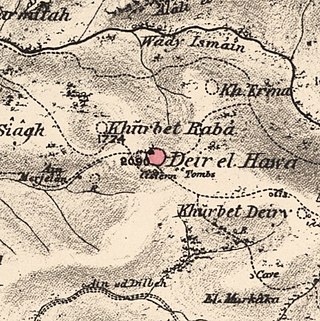
Dayr al-Hawa was a Palestinian Arab village in the Jerusalem Subdistrict. The village was depopulated during the 1948 Arab-Israeli War on October 19, 1948, by the Fourth Battalion of the Har'el Brigade of Operation ha-Har. It was located 18.5 km west of Jerusalem.

Al-Samra was a Palestinian Arab village in the Tiberias Subdistrict. It was depopulated on April 21, 1948, during the 1947–1948 Civil War in Mandatory Palestine. It was located 10 km southeast of Tiberias.

Travelogues of Palestine are the written descriptions of the region of Palestine by travellers, particularly prior to the 20th century. The works are important sources in the study of the history of Palestine and of Israel. Surveys of the geographical literature on Palestine were published by Edward Robinson in 1841, Titus Tobler in 1867 and subsequently by Reinhold Röhricht in 1890. Röhricht catalogued 177 works between 333 – 1300 CE, 19 works in the 14th century, 279 works in the 15th century, 333 works in the 16th century, 390 works in the 17th century, 318 works in the 18th century and 1,915 works in the 19th century.
Bebnine is a town located in the Akkar District of the Akkar Governorate in Lebanon. Its inhabitants are primarily Sunni Muslims.
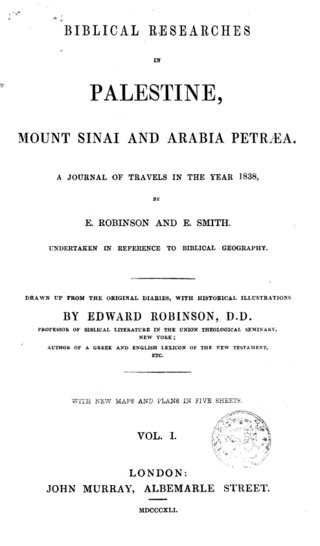
Biblical researches in Palestine, Mount Sinai and Arabia Petraea, also Biblical Researches in Palestine and the Adjacent Regions, was a travelogue of 19th-century Palestine and the magnum opus of the "Father of Biblical Geography", Edward Robinson. The work was published simultaneously in England, the United States and Germany.

The Ordnance Survey of Jerusalem of 1864–65 was the first scientific mapping of Jerusalem, and the first Ordnance Survey to take place outside the United Kingdom. It was undertaken by Charles William Wilson, a 28-year-old officer in the Royal Engineers corps of the British Army, under the authority of Sir Henry James, as Superintendent of the Ordnance Survey, and with the sanction of George Robinson, 1st Marquess of Ripon as Secretary of State for War. The team of six Royal Engineers began their work on 3 October 1864. The work was completed on 16 June 1865, and the report was published on 29 March 1866.
The cartography of the region of Palestine, also known as cartography of the Holy Land and cartography of the Land of Israel, is the creation, editing, processing and printing of maps of the region of Palestine from ancient times until the rise of modern surveying techniques. For several centuries during the Middle Ages it was the most prominent subject in all of cartography, and it has been described as an "obsessive subject of map art".

The Van de Velde maps of Palestine and Jerusalem were an important scientific mapping of the region of Palestine and mapping of Jerusalem, published in 1858 by Dutch cartographer Charles William Meredith van de Velde.

The 1840–41 Royal Engineers maps of Palestine, Lebanon and Syria was an early scientific mapping of Palestine, Lebanon and Syria.
Cheikh Taba is a town in Akkar Governorate, Lebanon, close to the border with Syria.
Sayssouq is a village in Akkar Governorate, Lebanon.
Hrar is a village in Akkar Governorate, Lebanon.

Khreibet Ej Jindi is a town in Akkar Governorate, Lebanon.
Haytla is a town in Akkar Governorate, Lebanon.

